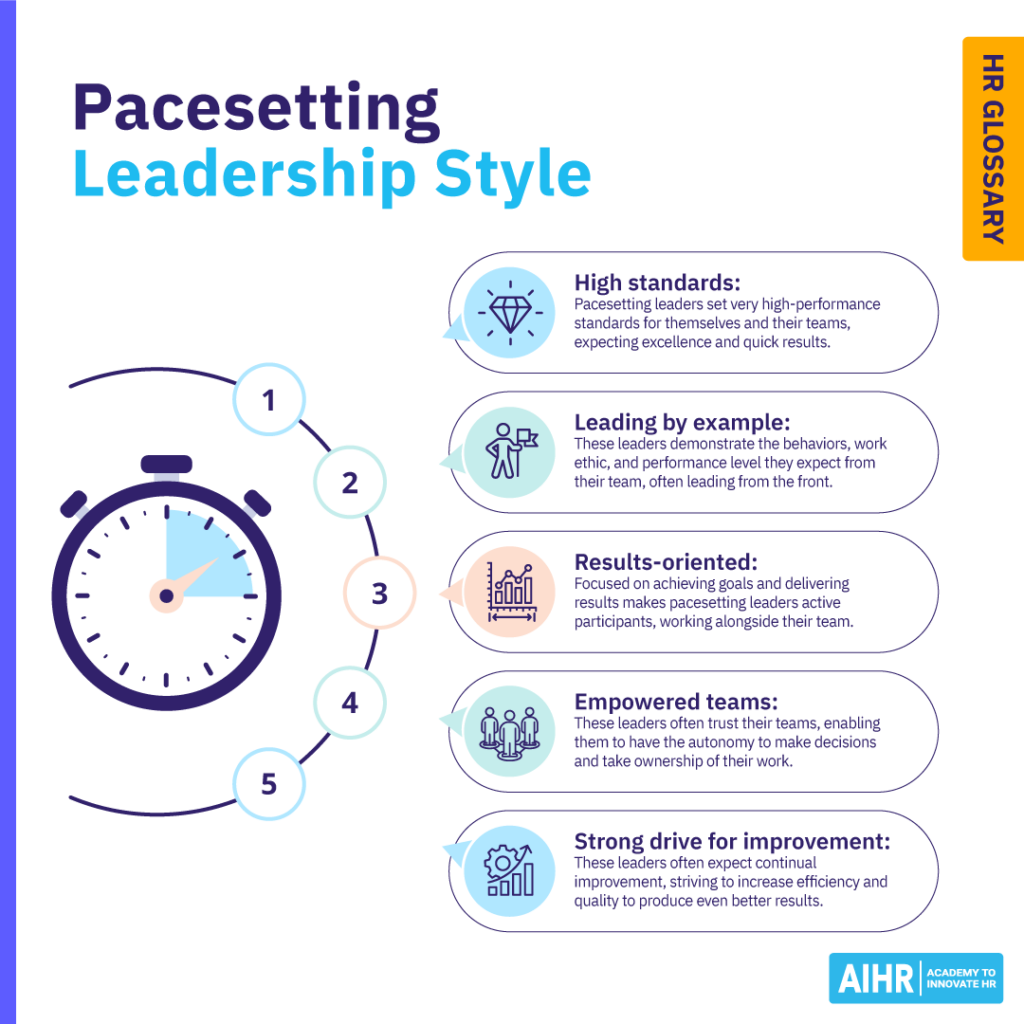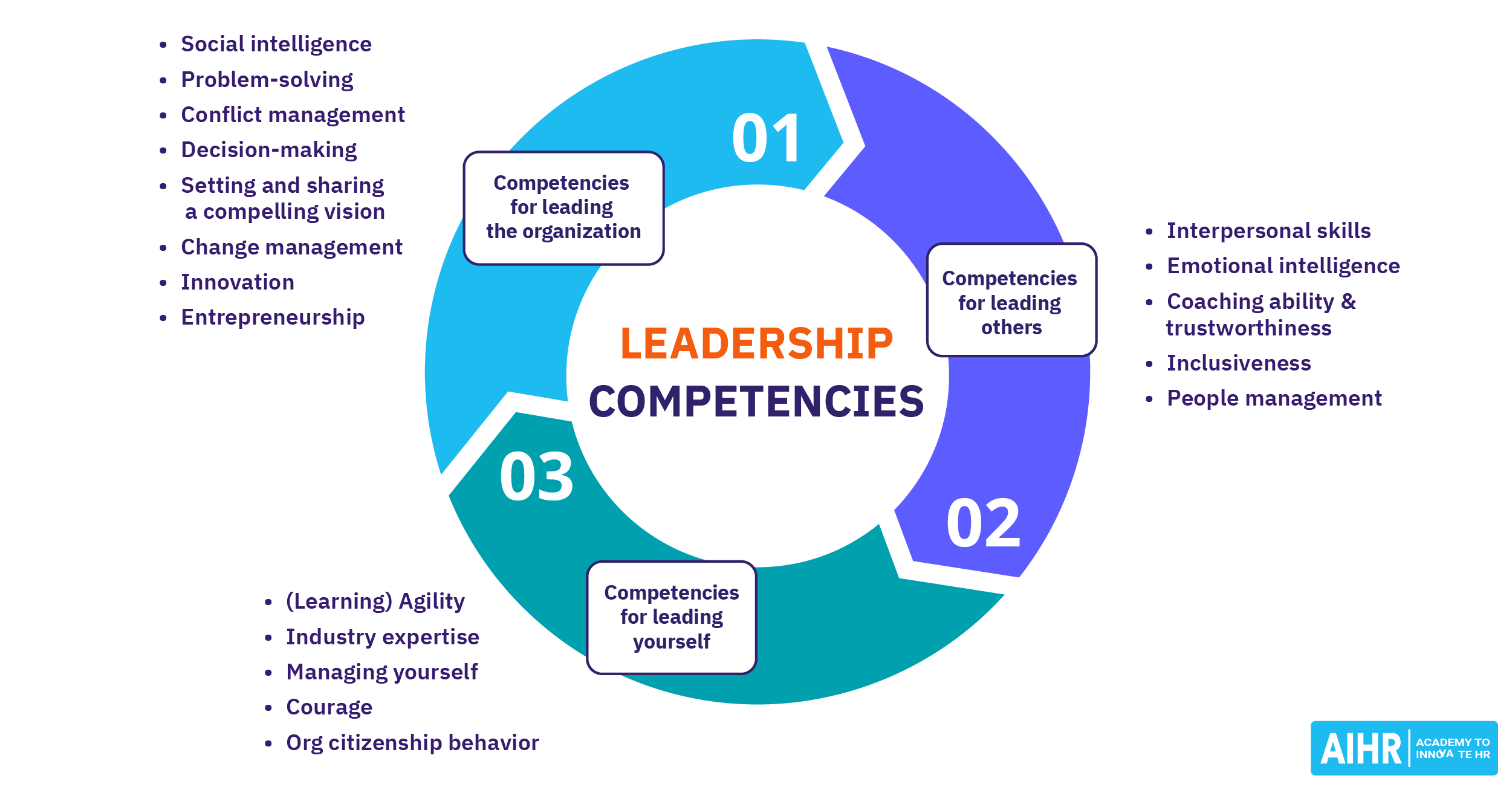Pacesetting Leadership
What is pacesetting leadership?
Pacesetting leadership is a results-driven style in which leaders set high-performance standards and lead by example. Under this leadership style, teams are expected to match the leader’s behaviors, work ethic, and efforts. Success is measured by how well teams meet ambitious goals and consistently deliver high-quality work.
Pacesetting leadership is one of six leadership styles developed by Daniel Goleman, a leading psychologist known for his work on emotional intelligence. While a pacesetting style of leadership can drive high performance, it is most effective when combined with other leadership styles and should not be used exclusively. It can, however, be particularly beneficial for completing critical projects within limited timeframes.
Characteristics of the pacesetting leadership style
Since a pacesetting style of leadership is often associated with achieving ambitious goals, it is often associated with these key characteristics:
- High standards: Pacesetting leaders set very high performance standards for themselves and their teams, expecting excellence and quick results.
- Leading by example: These leaders demonstrate the behaviors, work ethic, and performance level they expect from their team, often leading from the front.
- Results-oriented: A focus on achieving goals and delivering results makes pacesetting leaders active participants who work alongside their team.
- Empowered teams: These leaders often trust their teams, giving them the autonomy to make decisions and take ownership of their work.
- Strong drive for improvement: Under this leadership style, leaders often expect continual improvement, striving to increase efficiency and quality to produce even better results.

Pacesetting leadership style examples
Here are some real-world examples of famous pacesetting leaders:
- Jack Welch, former CEO of General Electric (1981-2001): Welch was well-known for creating a high-achieving environment, combining pacesetting and authoritative leadership approaches. Teams were driven to meet ambitious targets, which made GE one of the most successful companies under Welch’s tenure. Employees who could not keep pace with performance standards (the bottom 10% of performers based on stack ranking) were terminated.
- Lee Kuan Yew, first Prime Minister of Singapore (1959-1990): Lee’s results-oriented leadership approach played a significant role in transforming Singapore from a developing nation into Asia’s top financial hub. His high standards contributed to marked improvements in Singapore’s education, housing, and infrastructure.
- Satya Nadella, CEO of Microsoft (2014-present): One of the most contemporary and excellent models of pacesetting leadership is Nadella’s role in transforming Microsoft’s culture. He shifted the company’s highly competitive, siloed environment to one more focused on collaboration, growth, and continuous learning. Nadella has modeled these qualities while setting high standards that continue positioning Microsoft as a tech industry leader.
Pacesetting leadership pros and cons
Like most leadership styles, pacesetting leadership offers several advantages and disadvantages:
Clear performance expectations: Leaders outlining performance expectations helps keep teams on track to meet key deliverables. It also clarifies details on performance evaluation.
Stress and burnout: Constant high performance expectations to meet ambitious goals can cause team members to feel overwhelmed and may lead to employee burnout over time.
Quick goal achievement: Pacesetting leaders establish clear targets and deliverables at the outset of projects, which can help teams stay on track to reach goals faster.
Limited individual contributions: Since the leader sets the goals and expectations, individual team members may not feel empowered to offer their unique perspectives and vision.
Increased innovation and creativity: Expecting teams to meet high standards continually can encourage them to find innovative and creative solutions.
Fewer professional development opportunities: Focusing on achieving results quickly may not leave enough time to focus on one’s professional development, which can limit skill development and career advancement.
Enhanced collaboration: A shared sense of purpose drives everyone to work together to achieve goals. This shared vision can lead to a stronger team spirit.
Lack of variety: An emphasis on efficiency and achieving results quickly may cause some employees to feel their work is repetitive, which can reduce motivation and job satisfaction.
Industries and situations ideal for pacesetting leadership
Pacesetting leadership thrives in fast-paced, goal-oriented environments. The following are good examples:
- Sales and marketing: Achieving measurable targets like sales quotas and marketing campaign goals can be a good fit for a pacesetting leadership style. Teams in these environments have experience working under pressure to meet common goals.
- Startups: The initial stages of startups typically require small teams to reach results quickly, often on limited budgets. Pacesetting leadership can provide clear direction and performance expectations needed to drive startups’ growth and success.
- Short-term projects: Pacesetting leadership may not be suitable as an all-around leadership approach. It often works best when clear goals must be met within a short timeframe. A pacesetting leader can ensure the right pace to keep the project on track.
- Transitional situations: When a company is struggling or going through a major transformation, pacesetting leadership can be ideal for improving efficiency, reducing costs, or operational shifts within a set timeframe.
HR tip
It’s crucial to maintain employee wellbeing, particularly during transitional periods. HR should work closely with leaders to develop communication plans that explain the rationale, direction and expectations during such situations. Be prepared to offer extra resources to support employees during stressful periods to prevent burnout.
Other leadership styles by Goleman
Goleman identifies six distinct leadership styles, each based on emotional intelligence and suited to different situations. Besides the pacesetting style, here are the other five:
- Coercive leadership: This style demands immediate compliance from team members. The leader gives clear, direct commands and expects quick results. It is effective in crisis situations or when a rapid turnaround is necessary. However, it can negatively impact the work environment by stifling creativity and demotivating employees due to its authoritative approach.
- Authoritative leadership: This approach involves the leader setting a clear vision and direction for the team. The leader motivates team members by explaining how their roles contribute to the broader vision of the organization. It is most effective when a new direction or a clear vision is needed and positively impacts the climate by providing clarity and motivation through a shared sense of purpose.
- Affiliative leadership: This style emphasizes the creation of emotional bonds and harmony within the team. The leader focuses on teamwork and fostering a collaborative environment. It is particularly useful for healing rifts in a team or providing motivation during stressful times.
- Democratic leadership: In this style, the leader encourages participation and values input from team members in decision-making processes. It is effective when consensus is needed or when the leader aims to generate fresh ideas and foster commitment from the team.
- Coaching leadership: This style focuses on developing team members for the future. The leader helps individuals improve their performance by showing them how their work can be enhanced and by providing guidance for personal and professional growth. It is effective when the leader aims to build long-term strengths and promote personal development among team members.
FAQ
The pace model of leadership, also known as pacesetting leadership, is a leadership style where leaders set high standards for their teams’ or employees’ performance. Pacesetting leaders are results-oriented, leading by example to demonstrate desired behaviors and work ethic.
Indra Nooyi, former CEO of PepsiCo, is a strong example of a pacesetter leader. She was influential in setting ambitious business growth goals that greatly improved efficiency and streamlined operations.









